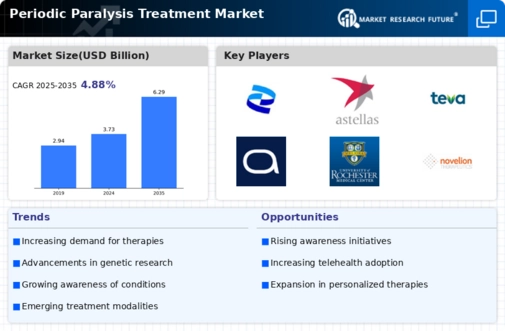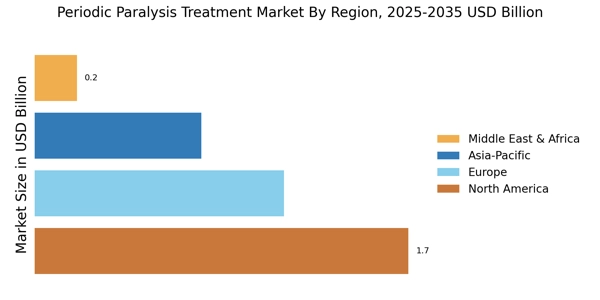Collaborative Research Efforts
Collaborative research efforts among academic institutions, healthcare providers, and pharmaceutical companies are emerging as a key driver for the Periodic Paralysis Treatment Market. These partnerships facilitate the sharing of knowledge, resources, and expertise, which is essential for advancing the understanding of periodic paralysis disorders. Collaborative initiatives often lead to the development of comprehensive treatment protocols and clinical trials that can accelerate the approval of new therapies. Recent collaborations have resulted in promising clinical outcomes, indicating the potential for improved patient care. As these collaborative efforts continue to grow, they are expected to significantly impact the landscape of the Periodic Paralysis Treatment Market.
Increased Awareness and Education
The growing awareness and education surrounding periodic paralysis disorders are crucial drivers for the Periodic Paralysis Treatment Market. Initiatives aimed at educating healthcare professionals and the general public about these conditions are becoming more prevalent. This increased awareness leads to earlier diagnosis and treatment, which is essential for managing symptoms effectively. Furthermore, patient advocacy groups are playing a vital role in disseminating information and supporting research efforts. As more individuals become informed about periodic paralysis, the demand for effective treatment options is expected to rise, thereby contributing to the expansion of the Periodic Paralysis Treatment Market.
Rising Prevalence of Periodic Paralysis
The increasing incidence of periodic paralysis disorders is a primary driver for the Periodic Paralysis Treatment Market. Recent estimates suggest that these conditions affect a significant number of individuals worldwide, with prevalence rates varying by type. For instance, hypokalemic periodic paralysis is reported to affect approximately 1 in 100,000 individuals. This rising prevalence necessitates the development of effective treatment options, thereby propelling market growth. As awareness of these disorders increases, more patients are likely to seek medical attention, further driving demand for innovative therapies. The growing patient population is expected to stimulate research and development efforts, leading to the introduction of novel treatment modalities in the Periodic Paralysis Treatment Market.
Rising Investment in Rare Disease Research
The surge in investment directed towards rare disease research is a significant factor influencing the Periodic Paralysis Treatment Market. Governments and private organizations are increasingly recognizing the need to address the challenges posed by rare diseases, including periodic paralysis. This trend is reflected in the growing number of grants and funding opportunities available for research initiatives focused on these conditions. For instance, recent funding reports indicate a marked increase in financial support for studies aimed at understanding the underlying mechanisms of periodic paralysis. Such investments are likely to foster innovation and lead to the development of new therapeutic options, thereby enhancing the Periodic Paralysis Treatment Market.
Technological Advancements in Treatment Options
Technological innovations in the field of medicine are significantly influencing the Periodic Paralysis Treatment Market. The advent of advanced therapeutic techniques, such as gene therapy and targeted drug delivery systems, has the potential to revolutionize treatment approaches. These advancements not only enhance the efficacy of existing treatments but also pave the way for the development of new therapies tailored to individual patient needs. For example, recent studies indicate that gene editing technologies may offer promising solutions for genetic forms of periodic paralysis. As these technologies continue to evolve, they are likely to attract investment and research funding, thereby accelerating growth in the Periodic Paralysis Treatment Market.


















Leave a Comment